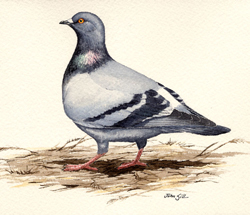Breeding Bird Atlases (BBA)
Find a Bird - BBA1
Breeding Bird Atlas 1 Species Accounts
Rock Dove
Columba livia
Egg Dates
throughout year; mostly March to June and August to November
Number of Broods
two or more each year, overlapping occasionally; can be up to six per year

Along with the other two prominent alien imports, the House Sparrow and the European Starling, the Rock Dove is one of Massachusetts’ most familiar birds. Despite their many admirable traits, pigeons are often regarded with disdain by ornithologists, as well as by much of the general population.
Rock Doves were originally Palearctic in their distribution. Due to their ease of domestication, they soon became widespread throughout much of Europe. European colonists first introduced them into North America in the early 1600s. These ancestral birds eventually escaped or were released into the wild, resulting in a gradual colonization of the entire eastern seaboard.
Today, Rock Doves can be found almost worldwide, in cities, towns, and agricultural areas. In Massachusetts, they are most numerous around the larger cities, where they can find plenty of suitable nesting sites and cover in the form of buildings and bridges. Away from sprawling urban environs, Rock Doves are unevenly distributed throughout the Commonwealth wherever appropriate habitat exists. Agricultural buildings and bridge abutments frequently offer suitable breeding sites, and highways may provide a network geographically linking concentrated urban populations.
Rock Doves tend to aggregate in large flocks or parties at productive feeding areas. They forage on open ground, primarily in the morning or midafternoon. A variety of foods are eaten. In addition to human refuse and handouts, many weed seeds and fruits are taken. A few invertebrates and even cooked meat may also be consumed.
Rock Dove coloration and body size are extremely variable. Infusions of polymorphic traits still occur as domestic birds find their way into the existing feral populations. The natural coloration of the old-world Rock Dove is an overall blue-gray with a white rump. There are two transverse black bars across the wing and iridescence on the neck and upper breast. All of these features are diagnostic of the ancestral form. A myriad of feral varieties ranging in color from black through reddish brown to white can now be found in Massachusetts. The predominant morph is still very similar to the original import, although albinistic feathering is often present. The female Rock Dove is slightly smaller than the male and has less iridescence on the neck.
Pigeons, though nonmigratory, exhibit a well-documented homing ability. This ability undoubtedly evolved from their need to forage in fields located far away from their ancestral cliff nest sites. One of the most intensively studied of all birds, the Rock Dove has helped to reveal many mysteries of avian navigation. The birds appear to rely on the sun as a compass to find their way home, although on cloudy days they apparently also utilize the earth’s magnetic field. Olfactory cues and low-frequency sound may also be involved, but further research is still needed.
Rock Doves typically nest in crevices or on sheltered ledges, preferably in semidarkness. Buildings, bridges, and barns are used as replacements for their ancestral cliff nesting sites. They tend to choose sites close to a good food supply. Pigeons are monogamous and pair for life, and breeding can occur before the birds are nine months old. The pair bond is established by an elaborate display that includes strutting, bowing, cooing, tail fanning, and nibbling. These behaviors are followed by the male feeding the female and end ultimately in copulation. The post-copulatory flight display is easily observed. It is initiated by a series of loud wing claps that are produced when the wings are forcefully brought together on an exaggerated upstroke. The male then flies with the wings held in a pronounced V shape between wing claps.
Male Rock Doves usually select the nest site, which is invariably on a flat surface. Because subsequent nesting often occurs in the same nest, a mass of "fecal cement" is typically produced. This results from the fact that squabs (i.e., fledglings) do not defecate in fecal sacs. The two oval, glossy, white eggs hatch in two to three weeks, depending on season, although in summer an overlap of clutches can occur. Year-round nesting is possible because the young are fed "crop milk" and regurgitated seeds, although winter nesting is generally less successful, if it is attempted at all. Both males and females attend the nest; the male’s usual duty time is between 9:00 a.m. and 5:00 p.m. The squabs are fed "crop milk," a protein- and fat-rich secretion, three to four times a day for the first few days. By day 7, feedings include mostly seeds and are reduced to twice a day. Little is known about the life of the juveniles after fledging, but presumably this is a period of high mortality, particularly amidst the multiplicity of hazards they face in the urban areas that they prefer.
Map Legend and Data Summary
Atlas 1 data collected from 1975-1979


Note: common in urban areas or wherever suitable nesting structures exist
Thomas Aversa and Steven M. Arena



